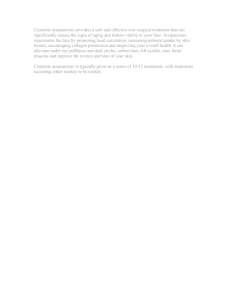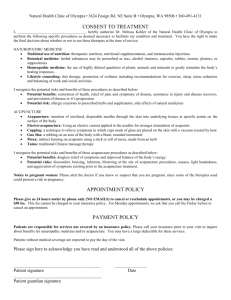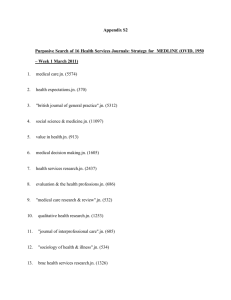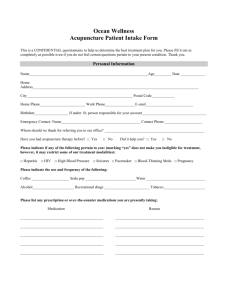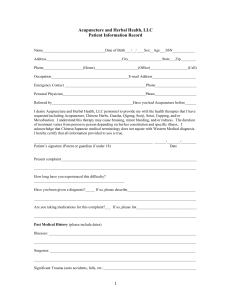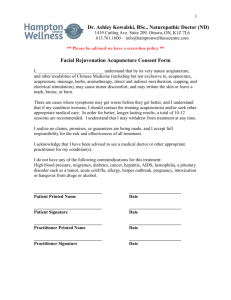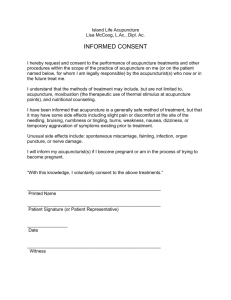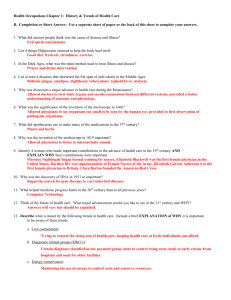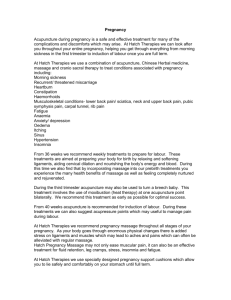CAM for Cancer Symptoms
advertisement
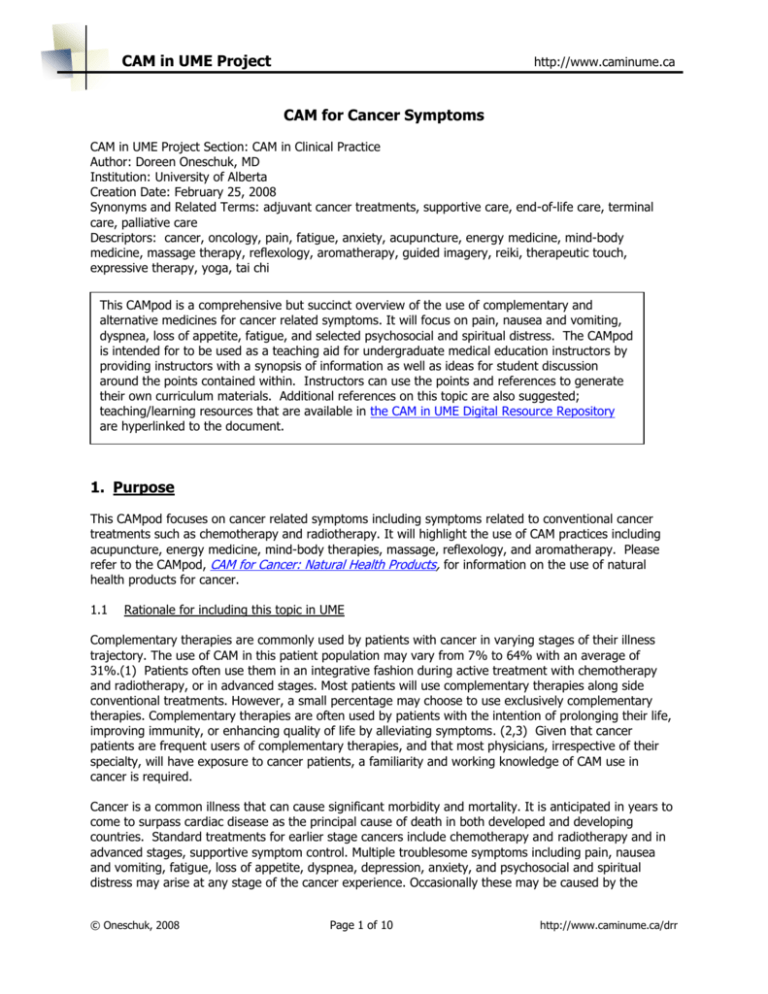
CAM in UME Project http://www.caminume.ca CAM for Cancer Symptoms CAM in UME Project Section: CAM in Clinical Practice Author: Doreen Oneschuk, MD Institution: University of Alberta Creation Date: February 25, 2008 Synonyms and Related Terms: adjuvant cancer treatments, supportive care, end-of-life care, terminal care, palliative care Descriptors: cancer, oncology, pain, fatigue, anxiety, acupuncture, energy medicine, mind-body medicine, massage therapy, reflexology, aromatherapy, guided imagery, reiki, therapeutic touch, expressive therapy, yoga, tai chi This CAMpod is a comprehensive but succinct overview of the use of complementary and alternative medicines for cancer related symptoms. It will focus on pain, nausea and vomiting, dyspnea, loss of appetite, fatigue, and selected psychosocial and spiritual distress. The CAMpod is intended for to be used as a teaching aid for undergraduate medical education instructors by providing instructors with a synopsis of information as well as ideas for student discussion around the points contained within. Instructors can use the points and references to generate their own curriculum materials. Additional references on this topic are also suggested; teaching/learning resources that are available in the CAM in UME Digital Resource Repository are hyperlinked to the document. . 1. Purpose This CAMpod focuses on cancer related symptoms including symptoms related to conventional cancer treatments such as chemotherapy and radiotherapy. It will highlight the use of CAM practices including acupuncture, energy medicine, mind-body therapies, massage, reflexology, and aromatherapy. Please refer to the CAMpod, CAM for Cancer: Natural Health Products, for information on the use of natural health products for cancer. 1.1 Rationale for including this topic in UME Complementary therapies are commonly used by patients with cancer in varying stages of their illness trajectory. The use of CAM in this patient population may vary from 7% to 64% with an average of 31%.(1) Patients often use them in an integrative fashion during active treatment with chemotherapy and radiotherapy, or in advanced stages. Most patients will use complementary therapies along side conventional treatments. However, a small percentage may choose to use exclusively complementary therapies. Complementary therapies are often used by patients with the intention of prolonging their life, improving immunity, or enhancing quality of life by alleviating symptoms. (2,3) Given that cancer patients are frequent users of complementary therapies, and that most physicians, irrespective of their specialty, will have exposure to cancer patients, a familiarity and working knowledge of CAM use in cancer is required. Cancer is a common illness that can cause significant morbidity and mortality. It is anticipated in years to come to surpass cardiac disease as the principal cause of death in both developed and developing countries. Standard treatments for earlier stage cancers include chemotherapy and radiotherapy and in advanced stages, supportive symptom control. Multiple troublesome symptoms including pain, nausea and vomiting, fatigue, loss of appetite, dyspnea, depression, anxiety, and psychosocial and spiritual distress may arise at any stage of the cancer experience. Occasionally these may be caused by the © Oneschuk, 2008 Page 1 of 10 http://www.caminume.ca/drr treatments themselves. Depending on the chemotherapy, patients may experience side effects of nausea and vomiting, peripheral neuropathy (neuropathic pain syndrome), fatigue, and leucopenia. Radiation therapy may cause fatigue and skin reactions. Patients often use CAM to reduce these side effects. 1.2 Key CAM Competencies The information in this CAMpod will contribute to enhancing CanMEDS competencies in the roles of Health Advocate, Communicator, Scholar, and Professional. The CAMpod will also contribute to meeting CAM-focused educational objectives from the list of core CAM competencies for undergraduate medical education available at http://www.caminume.ca/documents/competencies.pdf Specific Learning Objectives 1. Describe the frequency of cancer related CAM use, common reasons that patients with cancer choose to use CAM, and cancer patients’ expected benefits from using CAM. 2. Discuss the evidence base for using complementary modalities in the treatment of cancer pain, nausea and vomiting, fatigue, dyspnea, and anxiety/psychosocial distress according to the following subtopics: a) Acupuncture b) Energy Healing therapies such as Therapeutic Touch and Reiki c) Mind Body therapies ( or if preferred, Relaxation Therapies) such as Meditation, Hypnosis, and Guided Imagery d) Massage, Reflexology, and Aromatherapy 3. Describe an approach to initiating discussion on CAM and advising cancer patients regarding their use. 2. Overview It should be noted that CAM studies in cancer are often faulted for being limited in number, lacking adequate power, short duration, use of sham controls, and/or lack of methodological rigor. 2.1 Acupuncture 2.1.1 Cancer Pain Pain is a very common symptom in patients with cancer, particularly those with advanced disease. The proposed mechanism of action for pain involves the stimulation of small afferent sensory muscle nerve fibers that project to the spinal cord, and then proximally to the midbrain to ultimately involve the subcortical nuclei, limbic system, periaqueductal gray area, and pituitary gland Acupuncture studies have included cancer patients experiencing pain directly from the cancer and from cancer treatment. Most patients appear to obtain a moderate to above average effect from acupuncture, although duration of response varies ranging from hours to several months. Treatment frequency and duration of treatment are also variable in studies. Multiple treatments are often required to sustain pain relief. Patients reporting relief include those with malignant abdominal pain, bone metastases, and myofascial pain. In some studies, patients used fewer analgesics, experienced improved mobility as well as increased ability to complete their activities of daily living. Oneschuk D. Complementary, Non-Drug Therapies and Cancer Pain. Managing Cancer Pain. The Canadian Healthcare Professional’s Reference. Healthcare & Financial Publishing, 2005; 95-102. © Oneschuk, 2008 Page 2 of 10 http://www.caminume.ca/drr Johnson M. The clinical effectiveness of acupuncture for pain relief--you can be certain of uncertainty. Acupunct Med. 2006; Jun;24(2):71-9. Lee H, Schmidt K, Ernst E. Acupuncture for relief of cancer-related pain-a systematic review. European Journal of Pain 2005; 9: 437-444. Alimi D, Rubino C, Pichard-Leandri E, Fermand-Brule S. Analgesic effect of auricular acupuncture for cancer pain: a randomized, blinded, controlled trial. J of Clinical Oncology 2003; 21: 4120-4126. Alimi et al. conducted one of the few randomized, double blind controlled trials involving cancer patients. Two thirds of the 90 patients were women. Most had been treated for breast cancer, all had experienced neuropathic pain, and most had locoregional spread. All patients had a pain score on the visual analogue scale of at least 30 out of 100 (the greater the number, the most intense pain) after having received analgesic treatment adapted to both pain intensity and type of pain for at least a month. Group 1 received 2 courses of auricular acupuncture at electrodermal identified points; Group 2 received auricular acupuncture with no electrodermal signal (placebo points), and; Group 3 received auricular seeds fixed at placebo points. Pain intensity decreased by 36% at 2 months from baseline in the group receiving acupuncture. There was a 2% change for patients in the placebo groups. The difference between the groups was statistically significant. 2.1.2 Nausea and Vomiting Nausea, and to a lesser extent vomiting is prevalent following chemotherapy, with up to 60% of patients reporting nausea despite use of antiemetics. The evidence is mixed as to whether acupuncture is effective for chemotherapy-related nausea and vomiting. Response appears to be dependent on the type/mode of acupuncture and timing of administration. Ezzo J, Vickers A, Richardson MA, et al. Acupuncture-Point Stimulation for Chemotherapy-Induced Nausea and Vomiting. J of Clinical Oncology 2006;23: 7188-7198. Ezzo JM, Richardson MA, Vickers A, et al. Acupuncture-point stimulation for chemotherapy-induced nausea or vomiting (Review). Cochrane Collaboration Review, 2006, Issue 2. Streitberger K, Ezzo J, Schneider A. Acupuncture for nausea and vomiting: an update of clinical and experimental studies. Auton Neurosci 2006;129: 107-117. From the above 3 references: Electroacupuncture appears to benefit chemotherapy-induced acute vomiting (when added to standard antiemetics such as 5HT3 antagonists). Acupressure appears to reduce chemotherapy-induced acute nausea severity although studies with this modality did not involve a placebo control. It appears unlikely that noninvasive electrostimulation has a clinically relevant impact when patients are given state-of-the-art pharmacologic antiemetic therapy. Neither electrostimulation nor acupuncture appear to offer significant relief for delayed symptoms. However, anecdotally, physician practitioners have found acupuncture and electroacupuncture to be of benefit in late chemotherapy-induced nausea/emesis. Molassiotis A, Helin AM, Dabbour R, Hummerston S. The effects of P6 acupuncture in the prophylaxis of chemotherapy-related nausea and vomiting in breast cancer patients. Complement Ther Med. 2007 Mar;15(1):3-12. In Molassiotis et al.’s randomized controlled trial of 36 patients, acupressure was applied in the experimental group using wristbands to the Pericardium 6 (P6) acupoint for 5 days following © Oneschuk, 2008 Page 3 of 10 http://www.caminume.ca/drr chemotherapy. Nausea and the retching experience, and the nausea, vomiting, and retching occurrence were all significantly lower in the experimental group compared to the control group. 2.1.3 Dyspnea Cancer related dyspnea may be due to the direct effects of cancer, cancer treatment, or other comorbidities such as cardiac disease, or underlying respiratory disease i.e. COPD. This symptom frequently generates anxiety. The limited studies of acupuncture for cancer-related dyspnea also reveal varied results. Filshie J, Penn K, Ashley S, Davis CL. Acupuncture for the relief of cancer-related breathlessness. Palliative Medicine 1996; 10: 145-150. Filshie et al.’s recruited 20 patients who were breathless at rest and whose breathlessness was directly related to primary or secondary malignancy, sternal and LI4 acupuncture points. Seventy percent of the patients reported marked symptomatic benefit from treatment with significant changes in VAS scores of breathlessness, relaxation, and anxiety at least up to 6 hours post acupuncture. Overall, this study was of limited quality. Vickers A, Feinstein M, Deng G, Cassileth B. Acupuncture for dyspnea in advanced cancer: a randomized, placebo-controlled pilot trial. Biomed Central Palliative Care 2005; 18: 4:5. Vickers et al.’s study of 47 patients with lung or breast cancer patients presenting with dyspnea failed to show a significant improvement in dyspnea compared to placebo. Patients were randomized to receive a single session of true or placebo acupuncture in addition to their existing dyspnea treatments. Semi-permanent acupuncture ‘studs’ were inserted and patients applied pressure to these studs twice a day. The subjective sensation of dyspnea was assessed with a 010 numerical rating scale immediately before and after acupuncture treatment, and daily for a week thereafter. Overall, this was a high quality study. Acupuncture does not help cancer-associated dyspnoea. 2.1.4 Contraindications of Acupuncture Recommendations have been made to avoid acupuncture in the setting of thrombocytopenia and bleeding disorders, in addition to patients who are severely cachetic.(5) However, it can be considered that, in the absence of associated coagulation abnormalities, platelet counts of 40-50,000/microliter are sufficient for a major invasive procedure. Bone marrow biopsies can be safely performed at counts of less than 20,000 per microliter. Schiffer CA, Anderson KC, Bennett CL, et al. Platelet Transfusion for Patients with Cancer: Clinical Practice Guidelines of the American Society of Clinical Oncology. J of Clinical Oncology 2001; 19: 1519-1538. A low neutrophil count is not a contraindication for acupuncture with aseptic procedure or technique. Caution is warranted with deep muscle acupuncture points. Likewise, caution is required at sites of moist desquamation from radiation therapy: avoid limbs associated with severe lymphoedema as there is an increased risk of strept infection from any type of needle penetration. Avoid electroacupuncture if patient has a pacemaker or intracardiac defibrillator. Lu, W et al. Acupuncture for Chemotherapy-Induced Leukopenia: Exploratory Meta-Analysis of Randomized Controlled Trials. J Soc Integr Oncol. 2007;;5 (1):1-10. © Oneschuk, 2008 Page 4 of 10 http://www.caminume.ca/drr Deng, GE et al. Integrative Oncology Practice Guidelines. J Soc Integr Oncol. 2007; 5(2):65-84. 2.2 Energy Healing Therapies Although they appear to be safe, there is limited evidence showing the efficacy of energy therapies such as Therapeutic Touch or Reiki. There is presently no scientific evidence for their mechanism of action; however, these therapies may improve aspects of quality of life, provide a sense of control, and hope. The following three studies suggest some positive outcomes with the use of Energy Healing in cancer patients: Olson K, Hanson J, Michaud M. A phase II trial of Reiki for the management of pain in the advanced cancer patients. J of Pain and Symptom Management 2003; 26: 990-997. Tsang KL, Carlson LE, Olson K. Pilot crossover trial of Reiki versus rest for treating cancer related fatigue. Integr Cancer Ther 2007; 6: 25-35. Pohl G, Seemann H, Zojer N, et al. “Laying on of hands” improves well being in patients with advanced cancer. Support Care Cancer 2007; 15: 143-151. Mechanism of action can include actual touch (Reiki) and expectation, background music, and aromatherapy, for example. See: Pierce B. The use of biofield therapies in cancer care. Clin J Oncol Nurs. 2007 Apr;11(2):253-8. Engebretson J, Wardell DW. Experience of a Reiki session. Altern Ther Health Med. 2002;8(2):48-53. Wardell DW, Weymouth KF. Review of studies of healing touch. J Nurs Scholarsh. 2004;36(2):147-54. Roscoe JA, Morrow GR. Treatment of radiotherapy-induced fatigue through a nonpharmacological approach. Integr Cancer Ther 2005; 4: 8-13. 2.3 Mind Body Therapies/ Relaxation Techniques Although study results are also mixed, the evidence appears to be the most solid in the area of MindBody therapies. Based on the evidence, mind-body therapies can be recommended as part of a multidisciplinary approach to reduce anxiety, mood disturbance, chronic pain, and improve quality of life. Relaxation techniques include hypnosis, meditation, and guided imagery. All share two basic components: (1) repetitive focus on a word, sound, image, prayer, phrase, body sensation, or muscular activity, and (2) the adoption of a passive attitude toward intruding thoughts and a return to focus. As a group, relaxation techniques alter sympathetic activity with decreases in respiratory and heart rates, blood pressure, and oxygen consumption. Although the mechanisms responsible for the decreased sympathetic activity are unclear, decreased arousal due to alterations in catecholamine levels or other neurochemical systems is likely a contributor. © Oneschuk, 2008 Page 5 of 10 http://www.caminume.ca/drr 2.3.1 Meditation Meditation has been shown to be effective for cancer pain, psychosocial distress, and to improve quality of life. Meditation can result in improvement of cancer pain, reduction of anxiety and stress, improvement of psychosocial functioning, and enhance coping, well-being, and quality of life. Wallace K. Analysis of recent literature concerning relaxation and imagery interventions for cancer pain. Cancer Nurs 1997; 20: 79-87. Williams A-L. Selwyn P, Liberti L, et al. A Randomized Controlled Trial of Meditation and Massage Effects on Quality of Life in People with Late-Stage Disease: A Pilot Study. J of Palliative Medicine 2005; 8: 939-952 ( NB. A nice recent study but patient population was people with AIDS, not cancer). Speca M, Carlson L, Goodey E, Angen M. A Randomized, Wait-List Controlled Clinical Trial: The Effect of Mindfulness Meditation-Based Stress Reduction Program on Mood and Symptoms of Stress in Cancer Outpatients. Psychosomatic Medicine 2000; 62: 613-622. Ott MJ, Norris RL, Bauer-Wu SM. Mindfulness meditation for oncology patients: a discussion and critical review. Integr Cancer Ther 2006; 5: 98-108. Carlson LE, Speca M, Faris P, Patel KD. One year pre-post intervention follow-up of psychological, immune, endocrine, and blood pressure outcomes of mindfulness-based stress reduction (MBSR) in breast and prostate cancer outpatients. Brain Behav Immun 2007; 21: 1038-1049. 2.3.2 Hypnotherapy and Guided Imagery Hypnotherapy and Guided Imagery appear to assist in the management cancer pain, and chemotherapy side effects. Clinical hypnosis in cancer settings provides symptom reduction (pain and anxiety), and appears to lessen chemotherapy-induced nausea and vomiting. The benefits of hypnosis may be due to three possible mechanisms: immune enhancement due to a change in psychological state, a change in neurological arousal, and a change in consciousness. Marcus J, Elkins G, Mott F. A model of hypnotic intervention for palliative care. Adv Mind Body Med 2003; 19: 24-27. Rajasekaran M, Edmonds P, Higginson I. Systematic review of hypnotherapy for treating symptoms in terminally ill adult cancer patients. Palliative Medicine 2005; 19: 418-426. Yoo H, Ahn S, Kim S, Kim W, Han O. Efficacy of progressive muscle relaxation training and guided imagery in reducing chemotherapy side effects in patients with breast cancer and in improving their quality of life 2005; 13: 826-833. Neron S, Stephenson R. Effectiveness of hypnotherapy with cancer patients’ trajectory: emesis, acute pain, and analgesia and anxiolysis in procedures. Int J Clin Exp Hypn 2007; 55: 336-354. Richardson J, Smith JE, McCall G, et al. Hypnosis for nausea and vomiting in cancer chemotherapy: a systematic review of the research evidence. Eur J Cancer Care 2007; 16: 402-412. Richardson J, Smith JE, McCall G, Pilkington K. Hypnosis for Procedure-Related Pain and Distress in Pediatric Cancer Patients: A Systematic Review of Effectiveness and Methodology Related to Hypnosis Interventions. J Pain Symptom Manage. 2006; 31(1):70-84. © Oneschuk, 2008 Page 6 of 10 http://www.caminume.ca/drr Montgomery GH et al. A Randomized Clinical Trial of a Brief Hypnosis Intervention to Control Side Effects in Breast Surgery Patients. J. Natl. Cancer Inst. 2007; 99:1304-1312. 2.4 Massage, Reflexology, and Aromatherapy Multiple studies in cancer patients have found that massage helps to alleviate pain, induce relaxation, and lessen anxiety. The application of deep or intense pressure in cancer patients should be avoided, especially near lesions or enlarged lymph nodes, or other anatomic distortions. Patients with bleeding tendencies should receive only gentle, light-touch massage. There are few studies on reflexology. Cancer pain studies suggest that foot massage and reflexology both appear to decrease perceptions of pain, and induce relaxation. For example, Ross CSK, Hamilton J, Macrae G, et al. A pilot study to evaluate the effect of reflexology on mood and symptom rating of advanced cancer patients. Palliat Med 2002 ; 16 ; 544-545. In Ross et al.’s pilot study comparing reflexology to foot massage in cancer patients, the authors failed to demonstrate any superior effect of reflexology over simple foot massage. Stephenson N, Dalton J, Carlson J. The effect of foot reflexology on pain in patients with metastatic cancer. Appl Nurs Res 2003 ; 16 : 284-286. In Stephenson et al.’s study, foot reflexology was found to have positive immediate effects in patients with metastatic cancer who reported pain, although at 3 and 24 hours after the intervention, there was no statistically significant effect. Billhult A, Bergbom I, Stener-Victorin E. Massage relieves nausea in women with breast cancer who are undergoing chemotherapy. J Altern Complement Med 2007; 13: 53-57. In this study, 20 minutes of massage on five occasions versus a control group of five 20 minute visits, was found to be more effective in reducing nausea in women with breast cancer who were receiving chemotherapy. Other references to examine include: Cassileth B, Vickers A. Massage Therapy for Symptom Control: Outcome Study at a Major Cancer Center. J of Pain and Symptom Management 2004; 28: 244-249. Corbin L. Safety and Efficacy of Massage Therapy for Patients with Cancer. Cancer Control 2005; 12: 158164. Stephenson N, Weinrich S, Tavakoli A. The Effects of Foot Reflexology on Anxiety and Pain in Patients with Breast and Lung Cancer. Oncology Nursing Forum 2000; 27: 67-72. Aromatherapy massage appears to provide short term benefits on psychological wellbeing. Effects on physical symptoms may also occur. Evidence is mixed as to whether aromatherapy enhances the effects of massage. Kohara H, Miyauchi T, Seuhiro Y, et al. Combined Modality Treatment of Aromatherapy, Footsoak, and Reflexology Relieves Fatigue in Patients with Cancer. J of Palliative Medicine 2004; 7: 791-796 Wilkinson S, Aldridge J, Salmon I, Wilson B. An evaluation of aromatherapy massage in palliative care. Palliative Medicine 1999; 13: 409-417. © Oneschuk, 2008 Page 7 of 10 http://www.caminume.ca/drr Fellowes D, Barnes K, Wilkinson S. Aromatherapy and massage for symptom relief in patients with cancer (Review). Cochrane Collaboration 2005. Wilkinson SM, Love SB, Westcombe AM, et al. Effectiveness of aromatherapy massage in the management of anxiety and depression in patients with cancer: a multicenter randomized controlled trial. J Clin Oncol 2007, 25: 532-539. Sagar S, Dryden T, Wong R. Massage Therapy for Cancer Patients: A Reciprocal Relationship between Body and Mind. Current Oncology 2007; 14: 45-56. Mehling WE, Jacobs B, Acree M, et al. Symptom management with massage and acupuncture in postoperative cancer patients: a randomized controlled trial. J Pain Symptom Manage. 2007 Mar;33(3):258-66. Wilkinson S, Love S, Westcombe A, et al. Effectiveness of aromatherapy massage in the management of anxiety and depression in patients with cancer: A multicentre randomized controlled trial. Journal of Clinical Oncology, 2007;25(5):532-39. Stephen M. Sagar, Trish Dryden, Cynthia Myers. Research on Therapeutic Massage for Cancer Patients: Potential Biological Mechanisms. J Soc Integr Oncol. 2007. 5: 155-62. 2.5 Discussing CAM with Cancer Patients Health care providers have an important role in educating their patients about complementary therapies and helping them make informed decisions. The following is a step-by-step approach for initiating discussion on complementary therapies, and advising patients regarding their use.(4,5) Maintaining a non-judgmental attitude and a willingness to listen and learn is essential for this process. Patients can be supported without condoning particular therapies. The patients should be asked to identify principal symptoms that they wish to have addressed. Ask patients to maintain a daily symptom diary to compare pre- and post-treatment changes. Discuss the patient’s preferences and expectations regarding complementary therapies Review the safety and efficacy of the options patients are considering. Discourage any intervention that delays conventional treatments of proven efficacy. Identify a suitable licensed provider. Patients should be encouraged to review the professional credentials of a prospective therapy provider. Provide key questions for patients to ask providers, such as what the therapy consists of, expected frequency of visits, costs involved, time frame in which to assess benefit, potential side effects, and willingness to communicate findings and plans with the primary care providers. Schedule a follow-up visit or telephone call to review patient progress. Follow up and review the patient response to treatment. Document the process. For information on discussing CAM with patients in general, it may be helpful to look at the CAMpods Patient-Physician Communication about CAM and Approaching Patients Who Use CAM and Conventional Medicine which can be found in the CAM in UME Digital Resource Repository. Also go to: Cohen L, Cohen MH, Kirkwood C, Russell NC. Discussing Complementary Therapies in an Oncology Setting. J Soc Integr Oncol. 2007;5(1):18-24. © Oneschuk, 2008 Page 8 of 10 http://www.caminume.ca/drr 3. Discussion 3.1 Questions for Student Discussion and/or Reflection 1. Cancer patients are common users of complementary therapies. How would you counsel a cancer patient who presented to your office wanting to know whether she should receive acupuncture? Hypnosis? Massage? Would your advice differ if she had an early stage cancer that was potentially curable, versus advanced disease? If so, explain your rationale. 2. The evidence base for the use of complementary therapies in cancer is mixed. How might you design a study to determine if aromatherapy was of benefit to patients with advanced cancer? What are some possible challenges? 3.2 Readings 3.2.1 Annotated Readings Barraclough J. Integrated Cancer Care. Holistic, Complementary, and Creative Approaches. Oxford University Press, Oxford, 2001. This easy to read book explores the background of holistic health care and discusses a number of specific therapies such as acupuncture, homeopathy, hypnosis, guided imagery, and psychospiritual approaches. Also reviewed is the delivery of these therapies within different healthcare disciplines and settings. Barraclough J. Enhancing Cancer Care: Complementary Therapy and Support, Oxford University Press, Oxford, 2007 This is a second edition of the above book with new chapters that are categorized under Principles and Settings including the Oncology and Hospice Settings, and the ABC of Therapies which include chapters on Acupuncture, Aromatherapy, Exercise, Massage, Spiritual Care and others. Cohen A, Menter A, Hale L. Acupuncture: Role in Comprehensive Cancer Care- A Primer for the Oncologist and Review of the Literature. Integrative Cancer Therapies 2005; 4: 131-143. This article provides a comprehensive well written review of the role of acupuncture in cancer care. Topics include the background of acupuncture, historical problems with acupuncture research, physiologic background, immune effects, rationale for use in cancer patients, uses including antiemetic effects, pain control, fatigue, mood disorders and quality of life, dyspnea, dry mouth, flushing, and adverse reactions to acupuncture. Deng GE, Cassileth BR, Lorenzo C, et al. Integrative Oncology Practice Guidelines, J of the Society for Integrative Oncology 2007; 5(2): 65-84. This recent article, endorsed by the Society for Integrative Oncology, provides recommendations on various complementary therapy practices based on rationale and evidence-based information. Barida A, Arton DL, Prokop J, et al. Efficacy of Complementary and Alternative Medicine Therapies in Relieving Cancer Pain: A Systematic Review Conclusion of the paper: ‘There is a paucity of multi-institutional RCTs evaluating CAM interventions for cancer pain with adequate power, duration, and sham control. Hypnosis, imagery, support groups, acupuncture, and healing touch seem promising, particularly in the short term, but non can be recommended because of paucity of rigorous trials.’ Ernst E, Pittler MH, Wider B, Boddy K. Complementary/alternative medicine for supportive cancer care: development of the evidence-base. Support Care Cancer 2007; 15: 565-568. © Oneschuk, 2008 Page 9 of 10 http://www.caminume.ca/drr This article compares the evidence relating to the effectiveness of complementary/alternative medicine in palliative cancer care as it existed in 2000 and 2005. 3.2.2 CAMpod Reference List 1. Ernst E. Cassileth BR. Ther prevalence of complementary/alternative medicine in cancer: a systematic review. Cancer 1998;83:777-782. 2. Oneschuk D, Bruera E. The Potential Dangers of Complementary Therapy Use in a Patient with Cancer. J Pallaitive Care 1999;15:49-52. 3. Downer SM, Cody MM, McCluskey P, Wilson PD, Arnott SJ, Lister TA, Slevin ML. Pursuits and practice of complementary therapies by cancer patients receiving conventional treatment. BMJ 1994;309:8689. 4. Eisenberg DM. Advising patients who seek alternative medical therapies. Ann Intern Med 1997;127: 61-69. 5. Weiger W, Smith M, Boon H, Richardson M, Kaptchuk T, Eisenberg D. Advising patients who seek complementary and alternative medical therapies for cancer. Annals of Internal Medicine 2002; 137: 889-903. 3.2.3 Additional Readings The following reference articles discuss the many of the complementary therapies listed above, including references to and summaries of research studies. Deng G, Cassileth B. Integrative Oncology: Complementary Therapies for Pain, Anxiety, and Mood Disturbance. CA Cancer Journal for Clinicians 2005; 55: 109-116. Deng G, Cassileth R, Yeung K. Complementary Therapies for Cancer-Related Symptoms. Supportive Oncology 2004; 2: 419-429. Sellick S, Zaza C. Critical review of 5 non pharmacologic strategies for managing cancer pain. Cancer Prevention & Control 1998; 2: 7-14. Other helpful references include: Sagar SM and Cassileth BR. Integrative Oncology for Comprehensive Cancer Centres: Definitions, Scope and Policy. Current Oncology. 2005;12 (3):103-117. Sagar SM. State of the Art and Science of Integrative Oncology: North America. J Soc Integr Oncol. 2005; 3: 127-9. Abrams D, Weil A (editors). Integrative Oncology. Oxford University Press; 2008. The following web site(s) provides information on CAM relating to cancer. CAM-Cancer: Complementary and alternative medicine assessment in the cancer field. Available at: http://www.cam-cancer.org/ (accessed February 25, 2008) © Oneschuk, 2008 Page 10 of 10 http://www.caminume.ca/drr
